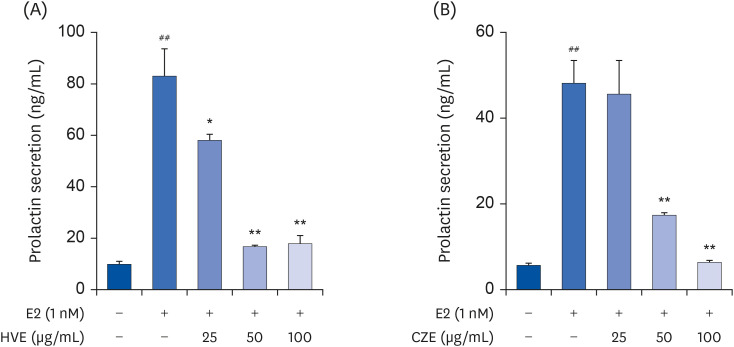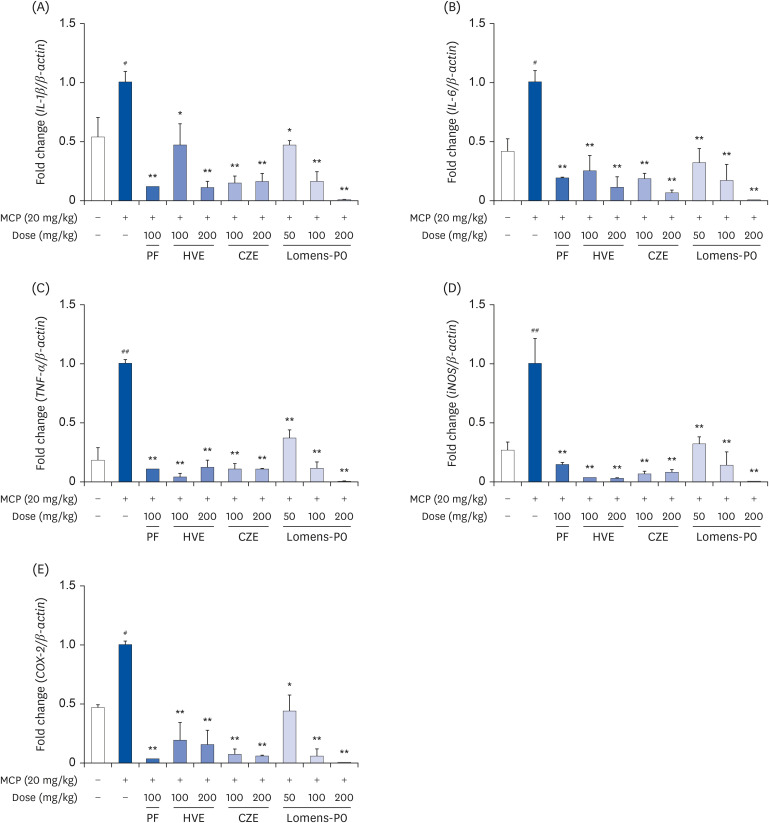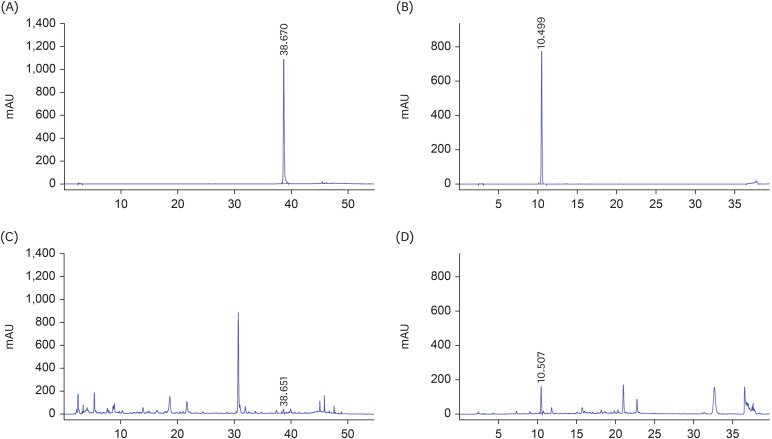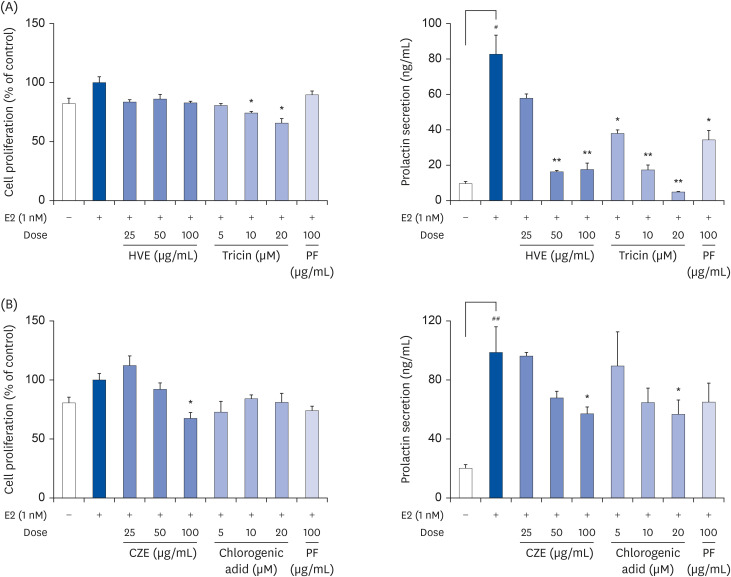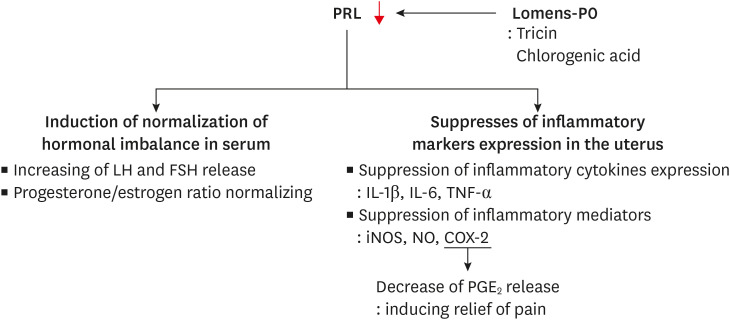Nutr Res Pract.
2021 Dec;15(6):715-731. 10.4162/nrp.2021.15.6.715.
Lomens-P0 (mixed extracts of Hordeum vulgare and Chrysanthemum zawadskii) regulate the expression of factors affecting premenstrual syndrome symptoms
- Affiliations
-
- 1Department of Oriental Medicine Biotechnology, College of Life Sciences, Kyung Hee University, Yongin 17104, Korea
- 2BioMedical Research Institute, Kyung Hee University, Yongin 17104, Korea
- 3Research Institute, Genencell Co. Ltd., Yongin 16950, Korea
- KMID: 2522652
- DOI: http://doi.org/10.4162/nrp.2021.15.6.715
Abstract
- BACKGROUND/OBJECTIVES
Premenstrual syndrome (PMS) is a disorder characterized by repeated emotional, behavioral, and physical symptoms before menstruation, and the exact cause and mechanism are uncertain. Hyperprolactinemia interferes with the normal production of estrogen and progesterone, leading to PMS symptoms. Thus, we judged that the inhibition of prolactin hypersecretion could mitigate PMS symptoms.
MATERIALS/METHODS
Hordeum vulgare L. extract (HVE), Chrysanthemum zawadskii var. latilobum extract (CZE), and Lomens-P0 the mixture of these extracts were tested in subsequent experiments. The effect of extracts on prolactin secretion at the in vitro level was measured in GH3 cells. Nitric oxide and pro-inflammatory mediator expression were measured in RAW 264.7 cells to confirm the anti-inflammatory effect. Also, the hyperprolactinemic Institute for Cancer Research (ICR) mice model was used to measure extract effects on prolactin and hormone secretion and uterine inflammation.
RESULTS
Anti-inflammatory effects of and prolactin secretion suppress by HVE and CZE were confirmed through in vitro experiments (P < 0.05). Treatment with Lomens-P0 inhibited prolactin secretion (P < 0.05) and restored normal sex hormone secretion in the hyperprolactinemia mice model. In addition, extracts significantly inhibited the expression of pro-inflammatory biomarkers, including interleukin-1β, and -6, tumor necrosis factor-α, inducible nitric oxide synthase, and cyclooxygenase-2 (P < 0.01). We used high-performance liquid chromatography analyses to identify tricin and chlorogenic acid as the respective components of HVE and CZE that inhibit prolactin secretion. The Lomens-P0, which includes tricin and chlorogenic acid, is expected to be effective in improving PMS symptoms in the human body.
CONCLUSIONS
The Lomens-P0 suppressed the prolactin secretion in hyperprolactinemia mice, normalized the sex hormone imbalance, and significantly suppressed the expression of inflammatory markers in uterine tissue. This study suggests that Lomens-P0 may have the potential to prevent or remedy materials to PMS symptoms.
Figure
Reference
-
1. Braverman PK. Premenstrual syndrome and premenstrual dysphoric disorder. J Pediatr Adolesc Gynecol. 2007; 20:3–12. PMID: 17289510.
Article2. Hong JP, Park S, Wang HR, Chang SM, Sohn JH, Jeon HJ, Lee HW, Cho SJ, Kim BS, Bae JN, Cho MJ. Prevalence, correlates, comorbidities, and suicidal tendencies of premenstrual dysphoric disorder in a nationwide sample of Korean women. Soc Psychiatry Psychiatr Epidemiol. 2012; 47:1937–1945. PMID: 22538387.
Article3. Deuster PA, Adera T, South-Paul J. Biological, social, and behavioral factors associated with premenstrual syndrome. Arch Fam Med. 1999; 8:122–128. PMID: 10101982.
Article4. Hofmeister S, Bodden S. Premenstrual syndrome and premenstrual dysphoric disorder. Am Fam Physician. 2016; 94:236–240. PMID: 27479626.5. Pearlstein TB. Hormones and depression: what are the facts about premenstrual syndrome, menopause, and hormone replacement therapy? Am J Obstet Gynecol. 1995; 173:646–653. PMID: 7645647.
Article6. Schmidt PJ, Martinez PE, Nieman LK, Koziol DE, Thompson KD, Schenkel L, Wakim PG, Rubinow DR. Premenstrual dysphoric disorder symptoms following ovarian suppression: triggered by change in ovarian steroid levels but not continuous stable levels. Am J Psychiatry. 2017; 174:980–989. PMID: 28427285.
Article7. Yen JY, Wang PW, Su CH, Liu TL, Long CY, Ko CH. Estrogen levels, emotion regulation, and emotional symptoms of women with premenstrual dysphoric disorder: the moderating effect of estrogen receptor 1α polymorphism. Prog Neuropsychopharmacol Biol Psychiatry. 2018; 82:216–223. PMID: 29146473.
Article8. Osório FL, de Paula Cassis JM, Machado de Sousa JP, Poli-Neto O, Martín-Santos R. Sex hormones and processing of facial expressions of emotion: a systematic literature review. Front Psychol. 2018; 9:529. PMID: 29695991.
Article9. Freeman ME, Kanyicska B, Lerant A, Nagy G. Prolactin: structure, function, and regulation of secretion. Physiol Rev. 2000; 80:1523–1631. PMID: 11015620.10. Majumdar A, Mangal NS. Hyperprolactinemia. J Hum Reprod Sci. 2013; 6:168–175. PMID: 24347930.
Article11. Wira CR, Rodriguez-Garcia M, Patel MV. The role of sex hormones in immune protection of the female reproductive tract. Nat Rev Immunol. 2015; 15:217–230. PMID: 25743222.
Article12. Lennartsson AK, Jonsdottir IH. Prolactin in response to acute psychosocial stress in healthy men and women. Psychoneuroendocrinology. 2011; 36:1530–1539. PMID: 21621331.
Article13. Pałubska S, Adamiak-Godlewska A, Winkler I, Romanek-Piva K, Rechberger T, Gogacz M. Hyperprolactinaemia - a problem in patients from the reproductive period to the menopause. Przegl Menopauz. 2017; 16:1–7.
Article14. Seidlova-Wuttke D, Wuttke W. The premenstrual syndrome, premenstrual mastodynia, fibrocystic mastopathy and infertility have often common roots: effects of extracts of chasteberry (Vitex agnus castus) as a solution. Clin Phytoscience. 2017; 3:6.
Article15. Borba VV, Zandman-Goddard G, Shoenfeld Y. Prolactin and autoimmunity. Front Immunol. 2018; 9:73. PMID: 29483903.
Article16. Wang X, Ma L, Zhang EJ, Zou JL, Guo H, Peng SW, Wu JH. Water extract of Fructus Hordei Germinatus shows antihyperprolactinemia activity via dopamine D2 receptor. Evid Based Complement Alternat Med. 2014; 2014:579054. PMID: 25254056.17. Li MX, Liu H, Li Y, Wang F, Zhang PR, Zang P. Anti-hyperprolactinemic effect of formula malt decoction, a Chinese herbal cocktail. Trop J Pharm Res. 2015; 14:263–269.
Article18. Kim AR, Kim HS, Kim DK, Lee JH, Yoo YH, Kim JY, Park SK, Nam ST, Kim HW, Park YH, Lee D, Lee MB, Kim YM, Choi WS. The extract of Chrysanthemum zawadskii var. latilobum ameliorates collagen-induced arthritis in mice. Evid Based Complement Alternat Med. 2016; 2016:3915013. PMID: 27840652.19. Kim KY, Oh TW, Yang HJ, Kim YW, Ma JY, Park KI. Ethanol extract of Chrysanthemum zawadskii Herbich induces autophagy and apoptosis in mouse colon cancer cells through the regulation of reactive oxygen species. BMC Complement Altern Med. 2019; 19:274. PMID: 31638961.
Article20. Song HS, Kwon JE, Baek HJ, Kim CW, Jeon H, Ra JS, Lee HK, Kang SC. Sorghum fermented by Aspergillus oryzae NK enhances inhibition of vascular inflammation in TNF-α-stimulated human aortic smooth muscle cells. Int J Vitam Nutr Res. 2018; 88:309–318. PMID: 31237194.21. Skwarło-Sońta K. Prolactin as an immunoregulatory hormone in mammals and birds. Immunol Lett. 1992; 33:105–121. PMID: 1446915.
Article22. Pereira Suarez AL, López-Rincón G, Martínez Neri PA, Estrada-Chávez C. Prolactin in inflammatory response. Adv Exp Med Biol. 2015; 846:243–264. PMID: 25472542.23. McCallum RW, Sowers JR, Hershman JM, Sturdevant RA. Metoclopramide stimulates prolactin secretion in man. J Clin Endocrinol Metab. 1976; 42:1148–1152. PMID: 777023.
Article24. Ben-Jonathan N, Hnasko R. Dopamine as a prolactin (PRL) inhibitor. Endocr Rev. 2001; 22:724–763. PMID: 11739329.
Article25. Klein-Laansma CT, Jong M, von Hagens C, Jansen JP, van Wietmarschen H, Jong MC. Semi-individualized homeopathy add-on versus usual care only for premenstrual disorders: a randomized, controlled feasibility study. J Altern Complement Med. 2018; 24:684–693. PMID: 29565636.
Article26. Verkaik S, Kamperman AM, van Westrhenen R, Schulte PF. The treatment of premenstrual syndrome with preparations of Vitex agnus castus: a systematic review and meta-analysis. Am J Obstet Gynecol. 2017; 217:150–166. PMID: 28237870.27. Zamani M, Neghab N, Torabian S. Therapeutic effect of Vitex agnus castus in patients with premenstrual syndrome. Acta Med Iran. 2012; 50:101–106. PMID: 22359078.28. Silva LG, Ferguson BS, Faciola AP. Rapid communication: prolactin and hydrocortisone impact TNFα-mediated mitogen-activated protein kinase signaling and inflammation of bovine mammary epithelial (MAC-T) cells. J Anim Sci. 2017; 95:5524–5531. PMID: 29293766.29. Cerqueira RO, Frey BN, Leclerc E, Brietzke E. Vitex agnus castus for premenstrual syndrome and premenstrual dysphoric disorder: a systematic review. Arch Women Ment Health. 2017; 20:713–719.30. Sharma JN, Al-Omran A, Parvathy SS. Role of nitric oxide in inflammatory diseases. Inflammopharmacology. 2007; 15:252–259. PMID: 18236016.
Article31. Moreno-Carranza B, Bravo-Manríquez M, Baez A, Ledesma-Colunga MG, Ruiz-Herrera X, Reyes-Ortega P, de Los Ríos EA, Macotela Y, Martínez de la Escalera G, Clapp C. Prolactin regulates liver growth during postnatal development in mice. Am J Physiol Regul Integr Comp Physiol. 2018; 314:R902–8. PMID: 29466685.
Article32. Rondeau G, Merouani A, Phan V, Deal C, Robitaille P. Serum prolactin levels in a uremic child: effects of bilateral nephrectomy and kidney transplantation. NDT Plus. 2011; 4:303–306. PMID: 25984175.
Article33. Gunin AG, Emelianov V, Tolmachev AS, Tolmacheva A. Effect of prolactin and dopaminergic drugs on uterine response to chronic estrogen exposure. J Endocrinol. 2002; 172:61–69. PMID: 11786374.
Article34. Holm P, Shalmi M, Korsgaard N, Guldhammer B, Skouby SO, Stender S. A partial estrogen receptor agonist with strong antiatherogenic properties without noticeable effect on reproductive tissue in cholesterol-fed female and male rabbits. Arterioscler Thromb Vasc Biol. 1997; 17:2264–2272. PMID: 9351399.
Article35. Orkhon B, Kobayashi K, Javzan B, Sasaki K. Astragalus root induces ovarian β‑oxidation and suppresses estrogen‑dependent uterine proliferation. Mol Med Rep. 2018; 18:5198–5206. PMID: 30272268.
Article36. Sugimoto Y, Narumiya S. Prostaglandin E receptors. J Biol Chem. 2007; 282:11613–11617. PMID: 17329241.
Article37. Fischer DP, Griffiths AL, Lui S, Sabar UJ, Farrar D, O'Donovan PJ, Woodward DF, Marshall KM. Distribution and function of prostaglandin E2 receptors in mouse uterus: translational value for human reproduction. J Pharmacol Exp Ther. 2020; 373:381–390. PMID: 32205366.
- Full Text Links
- Actions
-
Cited
- CITED
-
- Close
- Share
- Similar articles
-
- Effect of Chrysanthemum zawadskii Extract on Dermal Papilla Cell Proliferation and Hair Growth
- Prevalence of Premenstrual Syndrome in Korean Female National Athletes and Associated Risk Factors
- Premenstrual syndrome & premenstrual dysphoric disorder
- The Relationships Among Premenstrual Syndrome, Automatic Thought, and Perfectionism of College Women Students
- Foeniculum vulgare as Valuable Plant in Management of Women's Health

